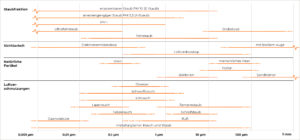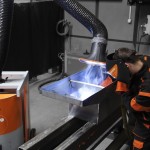How large are the particles in welding fumes?
Welders are exposed to small, dangerous particles every day: welding fume particles. Inhalation of these particles can be harmful to health. It is important to protect against them and to filter them out of the polluted air. But how large are these small particles and how dangerous are they?
Welding fume particles – The invisible danger
The processing of metals (e.g. in the form of welding or cutting) produces fumes and gases that are classified as hazardous substances under current regulations. Hazardous substances are substances, mixtures or products with hazardous properties that can cause chronic illness or harm to human health. Welding fumes are hazardous to health and, depending on the composition, can also be toxic or even mutagenic or carcinogenic.
The hazardous welding fumes consist of a mixture of different substances whose particles are generally so small that they can penetrate the pulmonary alveoli. Their size reaches down into the range of nanoparticles. But how large are nanoparticles actually? It is important to first be aware of the distribution in dimensions:
- 1 millimetre = 1,000 micrometres
- 1 micrometre = 1,000 nanometres
The following graphic illustrates the size ratios. Here, a fine dust particle in relation to a football is comparable to the size of a football to the earth.
 The finest particles are not visible to the naked eye. This is precisely what makes welding fumes so dangerous. Although we cannot perceive them, they are regarded as disease-causing toxins.
The finest particles are not visible to the naked eye. This is precisely what makes welding fumes so dangerous. Although we cannot perceive them, they are regarded as disease-causing toxins.
Coarse dust, fine dust, ultra-fine dust
Not all dust is the same as fine dust. The finer the dust, the deeper it can penetrate the human body and cause damage there. For this reason, dust is divided into different groups according to its particle size on a purely physical basis, whose boundary areas overlap.
- Coarse dust
Coarse dust is dust with a particle size of around 10 µm and larger. - Fine dust
Fine dust is a part of dust that remains in the atmosphere for a longer period of time, i.e. it is suspended in the air and does not immediately sink to the ground. These particles are among the smaller particle sizes down to around 20 nm (0.02 µm). - Ultra-fine dust
Ultra-fine dust is the term used to describe suspended particles that are smaller than 0.1 µm. These particles are 25-100x smaller than fine dust. They are so small that they can penetrate the cell membranes into the bloodstream and thus into the entire body.
Particles smaller than 0.01 µm belong to the range of gas molecules.
 Effects of welding fume particles on the body
Effects of welding fume particles on the body
In the case of particulate hazardous substances, such as welding fume particles, a distinction is made between inhalable dust (E-dust) and alveolar dust (A-dust). The particles in inhalable dust are often smaller than 10 µm. Alveolar dust penetrates the fine alveoli of the lungs. Its particles are mostly smaller than 2.5 µm. Particles that settle in the pulmonary alveoli hinder the exchange of gas from the air into the blood and vice versa. Studies show that almost all welding fume particles belong to the so-called ‘A-dust’. A certain proportion of welding fume particles are in the ultra-fine dust range. This is able to pass through cell membranes into the bloodstream, which means that welding fume particles can penetrate all areas of the body, even the brain. The health risks caused by welding fumes are large. It is important to be protected as far as possible against the invisible danger. One of the most important protective measures is the effective extraction of welding fumes using powerful and reliable extraction systems.





